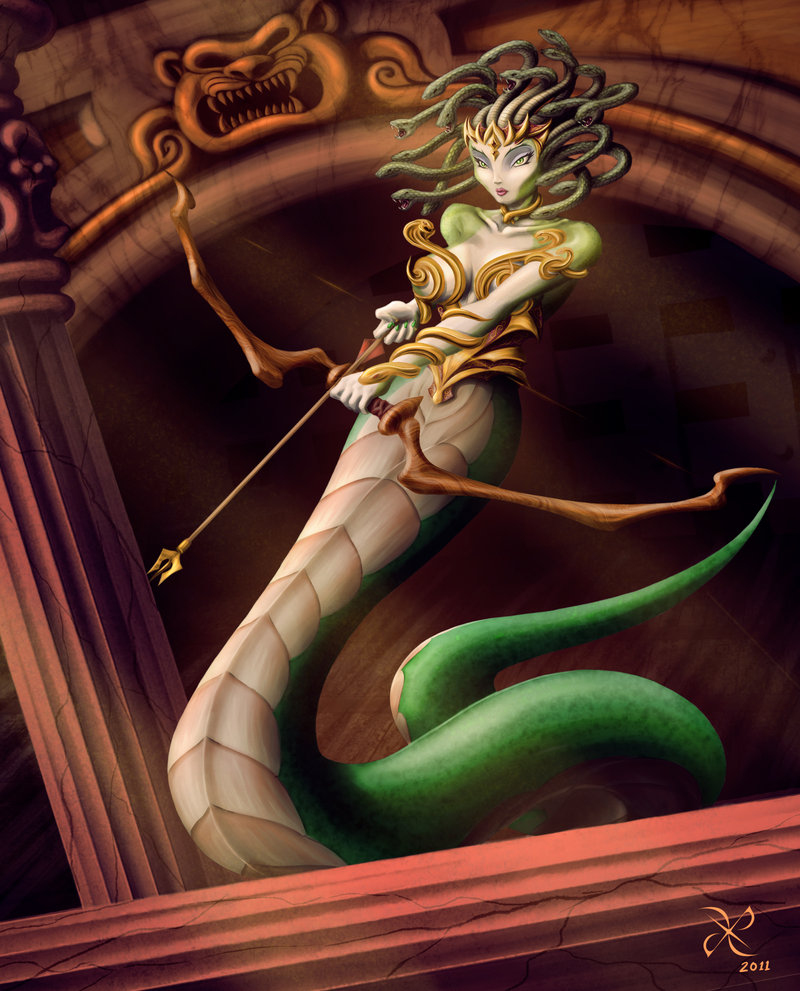Showing: All
Dragon
 Few creatures of folklore and mythology conjure up the mental images of the dragon. Also known as wurm, wyrm and firedrake, these mercurial creatures pervade almost every pantheon of classical mythology and have become an integral inclusion of an entire genre of fantasy literature.
Few creatures of folklore and mythology conjure up the mental images of the dragon. Also known as wurm, wyrm and firedrake, these mercurial creatures pervade almost every pantheon of classical mythology and have become an integral inclusion of an entire genre of fantasy literature.Descriptions of the beast's benevolence vary from the playful Puff (of Peter Yarrow's song) to the sinister Smaug in J.R.R. Tolkien's "The Hobbit". Babylonian legends portray the Queen of Darkness as a multi-headed dragon - Tiamat. Walt Disney's Sleeping Beauty features a battle between Prince Phillip and the evil Maleficent and the Germanic myth "Die Nibelungen" climaxes with the battle between Siegfried and the giant Fafnir, who has transformed himself into a wyrm in an effort to become more frightening.
Physical characteristics of dragons also vary but several consistencies are usually present. The beasts are typically depicted as huge lizards, larger than elephants on average. Long fangs are generally accepted as are twin horns of varying length. Western cultures generally include large bat-like wings giving the dragon the capability of flight. But eastern dragons, usually wingless, use a more magical means of flying. As well, eastern dragons tend to be more snake-like in nature, albeit with front and rear legs.
Most dragons will be covered in scales, although there are some with a leathery skin. Coloring ranges the entire gamut of the spectrum but red, green, black and gold appear to be the most common. It is also generally accepted that most dragons are magical creatures in nature and have the ability to breathe fire (as a weapon). Some dragons may have a modification in this breath weapon (frost, lightning, gas) but this appears to be purely a fabrication of fantasy role-playing games and the myths they spawn. (Encyclopedia Mythica by Graig Bakay)
Epimetheus
 Son of IAPETOS & KLYMENE, EPIMETHEUS was the Titan god of afterthought, the father of excuses. He and his brother Prometheus were given the task of populating the earth with animals and men. However, Epimetheus quickly exhausted the supply of gifts allotted for the task in the equipment of animals, leaving Prometheus' masterpiece, mankind, completely helpless. As a result the Titan brother was forced to steal fire from heaven to arm them. Zeus was angered by this theft and ordered the creation of Pandora, the first woman, as a means to deliver evil into the house of man. Despite the warnings of his brother, Epimetheus happily received her as his bride, but as soon as she arrived she lifted the lid of a jar entrusted her by the gods, releasing a plague of harmful daimones (spirits) to trouble mankind. Only Hope (Elpis) remained behind to succor the unfortunate race.
Son of IAPETOS & KLYMENE, EPIMETHEUS was the Titan god of afterthought, the father of excuses. He and his brother Prometheus were given the task of populating the earth with animals and men. However, Epimetheus quickly exhausted the supply of gifts allotted for the task in the equipment of animals, leaving Prometheus' masterpiece, mankind, completely helpless. As a result the Titan brother was forced to steal fire from heaven to arm them. Zeus was angered by this theft and ordered the creation of Pandora, the first woman, as a means to deliver evil into the house of man. Despite the warnings of his brother, Epimetheus happily received her as his bride, but as soon as she arrived she lifted the lid of a jar entrusted her by the gods, releasing a plague of harmful daimones (spirits) to trouble mankind. Only Hope (Elpis) remained behind to succor the unfortunate race.Helen of Troy
 Helen (often called "Helen of Troy") was the daughter of Leda and Zeus, and was the sister of the Dioscuri and Clytemnestra. Since Zeus visited Leda in the form of a swan, Helen was often presented as being born from an egg. She was reputed to be the most beautiful woman in the world. When Helen was still a child, she was abducted by Theseus. Since she was not yet old enough to be married, he sent her to Aphidnae and left her in the care of his mother, Aethra. The Dioscuri rescued her and returned her to her home in Lacedaemon, taking Aethra prisoner at the same time. When Helen reached marriageable age, all the greatest men in Greece courted her. Her mother's husband, King Tyndareos of Lacedaemon, was concerned about the trouble that might be caused by the disappointed suitors. Acting on the advice of Odysseus, he got all the suitors to swear that they would support the marriage rights of the successful candidate. He then settled on Menelaus to be the husband of Helen. She lived happily with Menelaus for a number of years, and bore him a daughter, Hermione.
Helen (often called "Helen of Troy") was the daughter of Leda and Zeus, and was the sister of the Dioscuri and Clytemnestra. Since Zeus visited Leda in the form of a swan, Helen was often presented as being born from an egg. She was reputed to be the most beautiful woman in the world. When Helen was still a child, she was abducted by Theseus. Since she was not yet old enough to be married, he sent her to Aphidnae and left her in the care of his mother, Aethra. The Dioscuri rescued her and returned her to her home in Lacedaemon, taking Aethra prisoner at the same time. When Helen reached marriageable age, all the greatest men in Greece courted her. Her mother's husband, King Tyndareos of Lacedaemon, was concerned about the trouble that might be caused by the disappointed suitors. Acting on the advice of Odysseus, he got all the suitors to swear that they would support the marriage rights of the successful candidate. He then settled on Menelaus to be the husband of Helen. She lived happily with Menelaus for a number of years, and bore him a daughter, Hermione.After a decade or so of married life, Helen was abducted by -- or ran off with -- Paris, the son of King Priam of Troy. Menelaus called on the other suitors to fulfill their oaths and help him get her back. As a result, the Greek leaders mustered the greatest army of the time, placed it under the command of Agamemnon, and set off to wage what became known as the Trojan War.
After the fall of Troy, Menelaus took Helen back to Lacedaemon, where they lived an apparently happy married life once more. After the end of their mortal existence, they continued to be together in Elysium.
There were a number of different accounts of Helen's relationship with Paris. In some, she was truly in love with him, although her sympathies were mostly with the Greeks who beseiged Troy. In others, she was a beautiful and wanton woman who brought disaster upon those around her. In still other accounts, she never went to Troy at all: Hermes, acting on Zeus's orders, spirited her away to Egypt and fashioned a phantom out of clouds to accompany Paris; the real Helen was reunited with Menelaus after the Trojan War.
Juno
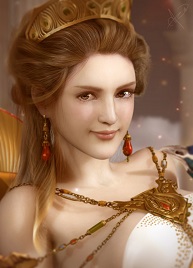 Juno one day perceived it suddenly grow dark, and immediately suspected that her husband had raised a cloud to hide some of his doings that would not bear the light. She brushed away the cloud, and saw her husband on the banks of a glassy river, with a beautiful heifer standing near him. Juno suspected the heifer's form concealed some fair nymph of mortal mould- as was, indeed, the case; for it was Io, the daughter of the river god Inachus, whom Jupiter had been flirting with, and, when he became aware of the approach of his wife, had changed into that form.
Juno one day perceived it suddenly grow dark, and immediately suspected that her husband had raised a cloud to hide some of his doings that would not bear the light. She brushed away the cloud, and saw her husband on the banks of a glassy river, with a beautiful heifer standing near him. Juno suspected the heifer's form concealed some fair nymph of mortal mould- as was, indeed, the case; for it was Io, the daughter of the river god Inachus, whom Jupiter had been flirting with, and, when he became aware of the approach of his wife, had changed into that form.Juno joined her husband, and noticing the heifer praised its beauty, and asked whose it was, and of what herd. Jupiter, to stop questions, replied that it was a fresh creation from the earth. Juno asked to have it as a gift. What could Jupiter do? He was loath to give his mistress to his wife; yet how refuse so trifling a present as a simple heifer? He could not, without exciting suspicion; so he consented. The goddess was not yet relieved of her suspicions; so she delivered the heifer to Argus, to be strictly watched.
Now Argus bad a hundred eyes in his head, and never went to sleep with more than two at a time, so that he kept watch of Io constantly He suffered her to feed through the day, and at night tied her up with a vile rope round her neck. She would have stretched out her arms to implore freedom of Argus, but she had no arms to stretch out, and her voice was a bellow that frightened even herself. She saw her father and her sisters, went near them, and suffered them to pat her back, and heard them admire her beauty. Her father reached her a tuft of grass, and she licked the outstretched hand. She longed to make herself known to him and would have uttered her wish; but, alas! words were wanting At length she bethought herself of writing, and inscribed her name- it was a short one- with her hoof on the sand. Inachus recognized it, and discovering that his daughter, whom he had long sought in vain, was hidden under this disguise, mourned over her, and, embracing her white neck, exclaimed, "Alas! my daughter, it would have been a less grief to have lost you altogether!" While he thus lamented, Argus, observing, came and drove her away, and took his seat on a high bank, from whence he could see all round in every direction.
Jupiter was troubled at beholding the sufferings of his mistress, and calling, Mercury told him to go and despatch Argus. Mercury made haste, put his winged slippers on his feet, and cap on his head, took his sleep-producing wand, and leaped down from the heavenly towers to the earth. There he laid aside his wings, and kept only his wand, with which he presented himself as a shepherd driving his flock. As he strolled on he blew upon his pipes. These were what are called the Syrinx or Pandean pipes. Argus listened with delight, for he had never seen the instrument before. "Young man," said he, "come and take a seat by me on this stone. There is no better place for your flocks to graze in than hereabouts, and here is a pleasant shade such as shepherds love." Mercury sat down, talked, and told stories till it grew late, and played upon his pipes his most soothing strains, hoping to lull the watchful eyes to sleep, but all in vain; for Argus still contrived to keep some of his eyes open though he shut the rest.
Among other stories, Mercury told him how the instrument on which he played was invented. … Before Mercury had finished his story he saw Argus's eyes all asleep. As his head nodded forward on his breast, Mercury with one stroke cut his neck through, and tumbled his head down the rocks. O hapless Argus! the light of your hundred eyes is quenched at once! Juno took them and put them as ornaments on the tail of her peacock, where they remain to this day.
But the vengeance of Juno was not yet satiated. She sent a gadfly to torment Io … At length Jupiter interceded for her, and upon his promising not to pay her any more attentions Juno consented to restore her to her form. It was curious to see her gradually recover her former self. The coarse hairs fell from her body, her horns shrank up, her eyes grew narrower, her mouth shorter; hands and fingers came instead of hoofs to her forefeet; in fine there was nothing left of the heifer, except her beauty. At first she was afraid to speak, for fear she should low, but gradually she recovered her confidence and was restored to her father and sisters. (Bulfinch’s Mythology)
Medusa the Gorgon
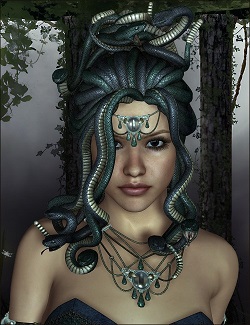 The myth of Medusa has several versions:
The myth of Medusa has several versions:One in which she asks to be allowed to see the sun; Athena says no; Medusa throws a fit and accuses Athena of jealousy of her beauty and Athena turns her into a snake-haired monster;
Another has Athena angry with her for having laid with Poseidon of her own free will in Athena’s temple and so turns Medusa into the beast for desecrating her temple; and
Yet another has Athena angry for the same reason but Medusa as a victim, being raped by Poseidon in Athena’s temple.
Bulfinch's Mythology describes her as, "once a beautiful maiden whose hair was her chief glory but as she dared to vie in beauty with Minerva (aka Athena), the goddess deprived her of her charms and changed her beautiful ringlets into hissing serpents. She became a cruel monster of so frightful an aspect that no living thing could behold her without being turned into stone."
GORGONS
In Greek mythology a Gorgon is a monstrous feminine creature whose appearance would turn anyone who laid eyes upon it to stone. Later there were three of them: Euryale ("far-roaming"), Sthenno ("forceful"), and Medusa ("ruler"), the only one of them who was mortal. They are the three daughters of Phorcys and Ceto.
The Gorgons are monstrous creatures covered with impenetrable scales, with hair of living snakes, hands made of brass, sharp fangs and a beard. They live in the ultimate west, near the ocean, and guard the entrance to the underworld.
A stone head or picture of a Gorgon was often placed or drawn on temples and graves to avert the dark forces of evil, but also on the shields of soldiers. Such a head (called a gorgoneion) could also be found on the older coins of Athens. Artists portrayed a Gorgon head with snake hair, and occasionally with a protruding tongue and wings. (Encyclopedia Mythica entry by Micha F. Lindemans)
Mermaid
 A marine creature with the head and upper body of a beautiful young maiden and with the lower body of a fish. She can be found in seas and lakes, or lying on a rock and combing her hair with one hand while holding a mirror in the other. Mermaids sometimes foretell the future and are often accompanied by seals. According to myth, they lure sailors by singing and with lovely music. They live in a kingdom on the bottom of the sea, and it is here they take their prisoners to. From this story, the fear amongst the sailor grew and they thought that seeing a mermaid would cause bad luck: it could predict death by drowning. The belief in mermaids is not limited to a few countries, but there are tales from all over the world (in India, for instance, there are the Apsara, beautiful water nymphs). However, most of those tales were told by sailors who "saw" them on their long journeys. (Encyclopedia Mythica by Micha F. Lindemans)
A marine creature with the head and upper body of a beautiful young maiden and with the lower body of a fish. She can be found in seas and lakes, or lying on a rock and combing her hair with one hand while holding a mirror in the other. Mermaids sometimes foretell the future and are often accompanied by seals. According to myth, they lure sailors by singing and with lovely music. They live in a kingdom on the bottom of the sea, and it is here they take their prisoners to. From this story, the fear amongst the sailor grew and they thought that seeing a mermaid would cause bad luck: it could predict death by drowning. The belief in mermaids is not limited to a few countries, but there are tales from all over the world (in India, for instance, there are the Apsara, beautiful water nymphs). However, most of those tales were told by sailors who "saw" them on their long journeys. (Encyclopedia Mythica by Micha F. Lindemans)Ah mermaids. One of the most sought after mythological creatures ever. Also one of the oldest and most often talked about mythological creatures. Tales of mermaids have been going back for as long as humans have been exploring the sea. Some people say that mermaids are exotically beautiful creatures. Others say that from afar they’re gorgeous … the closer you get to them ... the uglier they become. Some stories talk of mermaids being benevolent creatures, creatures willing to help humans who are in trouble or ships during storms. Other stories portray mermaids in a vastly different light. A rather chilling and eerie light. These stories…paint mermaids as malevolent creatures. Creatures who have no love towards humans and would routinely use their beauty to drag men down to the depths of the ocean just to drown them. This bit has been spun by the ages of time as mermaids not consciously wanting to drown the men they bring into the sea…but rather they forget that human males cannot breathe underwater. All of that aside…where did the idea of mermaids come from? Was it the Greeks? Romans? English? Surprisingly…for once it was none of these cultures. The mermaid myth started off in Syria around 1000 B.C . give or take a few years. According to the mythology there was a very beautiful Syrian Goddess named Atargatis. Legend has it that she was in love with a mortal shepard and somehow she accidentally and unintentionally caused his death. Ashamed by what she had done, she decided to jump into a lake and take on the form of a fish. This is where the story splits - one version says that the powers that be…the powers higher up than even the Gods and Goddesses could not allow and would not allow Atargatis to give up her divine beauty so only her bottom half was turned fish like while her top half remained human. The other version of this story says that the waters wouldn’t conceal her beauty so she was forced to take on the half fish, half human form herself to conceal herself. From there the myth has spun out into other cultures. For the Greeks..and later the Romans, Aphrodite also known by her Roman name Venus, came to be portrayed from time to time as mermaid…most likely because she’s a Goddess of beauty. Ironically though…the Greeks identified Atargatis as Dereko in their own mythology. As the stories mixed and changed and were passed down generations Atargatis/Dereko came to be considered the Syrian Goddess counterpart to Aphrodite/Venus. Mermaids became mixed up with sirens when Homer’s epic “The Odyessy†was written. Supposedly the Sirens had beautiful, beautiful voices and were even more beautiful to look upon..from afar at least. They would enchant sailors with their voices, trying to lure them closer to their islands. Sometimes the sailors would go overboard, spellbound by the voices and die trying to swim out to the island. Other times they’d make it out to the island only to discover the owner of the sweet voice was in fact a monster and would end up drowned, eaten or horribly doomed. Homer’s “The Odyessy†is what kicked off the majority of mermaid mythology. Everything from tales in the British Isles to One Thousand and One Nights (Known in English as Arabian Nights) to Hans Christian Anderson’s The Little Mermaid has styled mermaids as beautiful creatures with beautiful voices. Arabian Nights and Hans Christian Anders…and Disney since they made Hans Christian Anderson’s The Little Mermaid story into a movie..have romanticized mermaids and made them into the sweet, innocent, helpful benevolent creatures we believe them to be today. (pagenpages.org)
Pandora
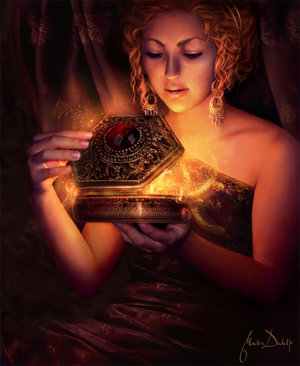 The first woman was named Pandora. She was made in heaven, every god contributing something to perfect her. Venus gave her beauty, Mercury persuasion, Apollo music, etc. Thus equipped, she was conveyed to earth, and presented to Epimetheus, who gladly accepted her, though cautioned by his brother to beware of Jupiter and his gifts. Epimetheus had in his house a jar, in which were kept certain noxious articles for which, in fitting man for his new abode, he had had no occasion. Pandora was seized with an eager curiosity to know what this jar contained; and one day she slipped off the cover and looked in. Forthwith there escaped a multitude of plagues for hapless man,- such as gout, rheumatism, and colic for his body, and envy, spite, and revenge for his mind,- and scattered themselves far and wide. Pandora hastened to replace the lid! but, alas! the whole contents of the jar had escaped, one thing only excepted, which lay at the bottom, and that was hope. So we see at this day, whatever evils are abroad, hope never entirely leaves us; and while we have that, no amount of other ills can make us completely wretched.
The first woman was named Pandora. She was made in heaven, every god contributing something to perfect her. Venus gave her beauty, Mercury persuasion, Apollo music, etc. Thus equipped, she was conveyed to earth, and presented to Epimetheus, who gladly accepted her, though cautioned by his brother to beware of Jupiter and his gifts. Epimetheus had in his house a jar, in which were kept certain noxious articles for which, in fitting man for his new abode, he had had no occasion. Pandora was seized with an eager curiosity to know what this jar contained; and one day she slipped off the cover and looked in. Forthwith there escaped a multitude of plagues for hapless man,- such as gout, rheumatism, and colic for his body, and envy, spite, and revenge for his mind,- and scattered themselves far and wide. Pandora hastened to replace the lid! but, alas! the whole contents of the jar had escaped, one thing only excepted, which lay at the bottom, and that was hope. So we see at this day, whatever evils are abroad, hope never entirely leaves us; and while we have that, no amount of other ills can make us completely wretched.Another story is that Pandora was sent in good faith, by Jupiter, to bless man; that she was furnished with a box containing her marriage presents, into which every god had put some blessing, She opened the box incautiously, and the blessings all escaped, hope only excepted. This story seems more probable than the former; for how could hope, so precious a jewel as it is, have been kept in a jar full of all manner of evils, as in the former statement?
Phoenix
 Ovid tells the story of the Phoenix as follows: "Most beings spring from other individuals; but there is a certain kind which reproduces itself. The Assyrians call it the Phoenix. It does not live on fruit or flowers, but on frankincense and odoriferous gums. When it has lived five hundred years, it builds itself a nest in the branches of an oak, or on the top of a palm tree. In this it collects cinnamon, and spikenard, and myrrh, and of these 'materials builds a pile on which it deposits itself, and dying, breathes out its last breath amidst odours. From the body of the parent bird, a young Phoenix issues forth, destined to live as long a life as its predecessor. When this has grown up and gained sufficient strength, it lifts its nest from the tree (its own cradle and its parent's sepulcher), and carries it to the city of Heliopolis in Egypt, and deposits it in the temple of the Sun." (Bulfinch’s Mythology)
Ovid tells the story of the Phoenix as follows: "Most beings spring from other individuals; but there is a certain kind which reproduces itself. The Assyrians call it the Phoenix. It does not live on fruit or flowers, but on frankincense and odoriferous gums. When it has lived five hundred years, it builds itself a nest in the branches of an oak, or on the top of a palm tree. In this it collects cinnamon, and spikenard, and myrrh, and of these 'materials builds a pile on which it deposits itself, and dying, breathes out its last breath amidst odours. From the body of the parent bird, a young Phoenix issues forth, destined to live as long a life as its predecessor. When this has grown up and gained sufficient strength, it lifts its nest from the tree (its own cradle and its parent's sepulcher), and carries it to the city of Heliopolis in Egypt, and deposits it in the temple of the Sun." (Bulfinch’s Mythology)Prometheus
 The Titan god of forethought and crafty counsel who was entrusted with the task of molding mankind out of clay. His attempts to better the lives of his creation brought him into direct conflict with Zeus. Firstly he tricked the gods out of the best portion of the sacrificial feast, acquiring the meat for the feasting of man. Then, when Zeus withheld fire, he stole it from heaven and delivered it to mortal kind hidden inside a fennel-stalk. As punishment for these rebellious acts, Zeus ordered the creation of Pandora (the first woman) as a means to deliver misfortune into the house of man, or as a way to cheat mankind of the company of the good spirits. Prometheus meanwhile, was arrested and bound to a stake on Mount Kaukasos where an eagle was set to feed upon his ever-regenerating liver (or, some say, heart). Generations later the great hero Herakles came along and released the old Titan from his torture.
The Titan god of forethought and crafty counsel who was entrusted with the task of molding mankind out of clay. His attempts to better the lives of his creation brought him into direct conflict with Zeus. Firstly he tricked the gods out of the best portion of the sacrificial feast, acquiring the meat for the feasting of man. Then, when Zeus withheld fire, he stole it from heaven and delivered it to mortal kind hidden inside a fennel-stalk. As punishment for these rebellious acts, Zeus ordered the creation of Pandora (the first woman) as a means to deliver misfortune into the house of man, or as a way to cheat mankind of the company of the good spirits. Prometheus meanwhile, was arrested and bound to a stake on Mount Kaukasos where an eagle was set to feed upon his ever-regenerating liver (or, some say, heart). Generations later the great hero Herakles came along and released the old Titan from his torture.Selkie
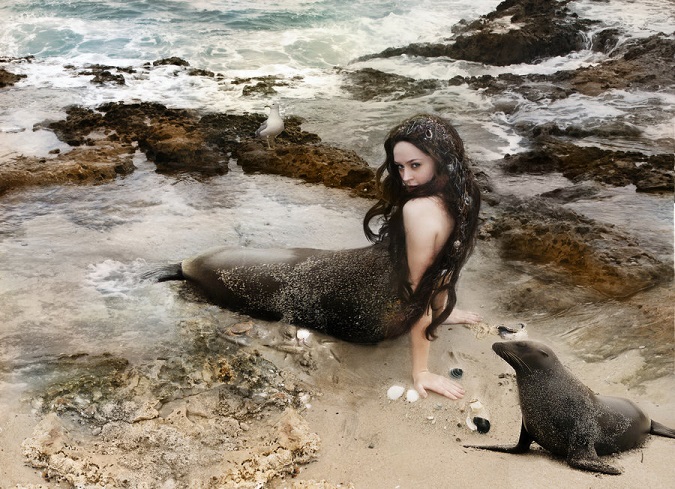 The shy Selkies are marine creatures in the shape of a seal. They can be found near the islands of Orkney and Shetland. A female can shed her skin and come ashore as a beautiful woman. When a man finds the skin, he can force the Selkie to be a good, if somewhat sad, wife. Should she ever recover the skin, she will immediately return to sea, leaving her husband behind. The male Selkies are responsible for storms and also for the sinking of ships, which is their way of avenging the hunting of seals. (Encyclopedia Mythica by Micha F. Lindemans)
The shy Selkies are marine creatures in the shape of a seal. They can be found near the islands of Orkney and Shetland. A female can shed her skin and come ashore as a beautiful woman. When a man finds the skin, he can force the Selkie to be a good, if somewhat sad, wife. Should she ever recover the skin, she will immediately return to sea, leaving her husband behind. The male Selkies are responsible for storms and also for the sinking of ships, which is their way of avenging the hunting of seals. (Encyclopedia Mythica by Micha F. Lindemans)Selkie is simply the Orcadian [Orkeny Islands in northern Scotland] dialect word for "seal".
So, selkies are a very common sight across Orkney. Heads bobbing above the waves, they are often seen by the shore, watching inquisitively with uncannily human eyes. To the onshore observer it is not hard to see how the legends surrounding the selkie-folk — the seal people — sprang into life. Orkney has many tales concerning this shape-shifting race. Unlike the Finfolk, who retained their malicious tendencies throughout the years, the selkie-folk have come to be regarded as gentle creatures, with the ability to transform from seals into beautiful, lithe humans. … In the surviving folklore, there is no agreement as to how often the selkie-folk were able to carry out the transformation. Some tales say it was once a year, usually Midsummer's Eve, while others state it could be “every ninth night†or “every seventh streamâ€. Regardless of how often they were able to transform, the folklore tells us that once in human form, the selkie-folk would dance on lonely stretches of moonlit shore, or bask in the sun on outlying skerries.
THE SELKIE SKIN
A common element in all the selkie-folk tales, and perhaps the most important, is the fact that in order to shapeshift they had to cast off their sealskins. Within these magical skins lay the power to return to seal form, and therefore the sea. If this sealskin was lost, or stolen, the creature was doomed to remain in human form until it could be recovered. Because of this, if disturbed while on shore, the selkie-folk would hastily snatch up their skins before rushing back to the safety of the sea.
AMOROUS ENCOUNTERS
The selkie-men were renowned for their many encounters with human females — married and unmarried. A selkie-man in human form was said to be a handsome creature, with almost magical seductive powers over mortal women. According to tradition, they had no qualms about casting off their sealskins, stashing them carefully, and heading inland to seek out “unsatisfied womenâ€. Should such a mortal woman wish to make contact with a selkie-man, there was a specific rite she had to follow. At high tide, she should make her way to the shore, where she had to shed seven tears into the sea. The selkie-man would then come ashore and, after removing his magical sealskin, seek out “unlawful loveâ€. In the words of the 19th century Orkney folklorist, Walter Traill Dennison, these selkie males: ". . . often made havoc among thoughtless girls, and sometimes intruded into the sanctity of married life."
If a girl went missing while out on the ebb, or at sea, it was inevitably said that her selkie lover had taken her to his watery domain — assuming, of course, she had not attracted the eye of a Finman. But while the males of the selkie race were irresistible to the island women, selkie-women were no less alluring to the eyes of earth-born men. The most common theme in selkie folklore is one in which a cunning young man acquires, either by trickery or theft, a selkie-girl’s sealskin. This prevents her from returning to the sea, leaving the seal-maiden with no option but to marry her “captorâ€. The tales generally end sadly, when the skin is returned, usually by one of the selkie-wife's children. In some accounts, her children go with her to the sea, while others have them remaining with their mortal father. The story of the Goodman o' Wastness is typical of one such tale.
Sphinx
 The city of Thebes was afflicted with a monster which infested the highroad. It was called the Sphinx. It had the body of a lion and the upper part of a woman. It lay crouched on the top of a rock, and arrested all travelers who came that way, proposing to them a riddle, with the condition that those who could solve it should pass safe, but those who failed should be killed. Not one had yet succeeded in solving it, and all had been slain. Oedipus was not daunted by these alarming accounts, but boldly advanced to the trial. The Sphinx asked him, "What animal is that which in the morning goes on feet, at noon on two, and in the evening upon three?" Oedipus replied, "Man, who in childhood creeps on hands and knees, in manhood walks erect, and in old age with the aid of a staff." The Sphinx was so mortified at the solving of her riddle that she cast herself down from the rock and perished. (Bulfinch’s Mythology)
The city of Thebes was afflicted with a monster which infested the highroad. It was called the Sphinx. It had the body of a lion and the upper part of a woman. It lay crouched on the top of a rock, and arrested all travelers who came that way, proposing to them a riddle, with the condition that those who could solve it should pass safe, but those who failed should be killed. Not one had yet succeeded in solving it, and all had been slain. Oedipus was not daunted by these alarming accounts, but boldly advanced to the trial. The Sphinx asked him, "What animal is that which in the morning goes on feet, at noon on two, and in the evening upon three?" Oedipus replied, "Man, who in childhood creeps on hands and knees, in manhood walks erect, and in old age with the aid of a staff." The Sphinx was so mortified at the solving of her riddle that she cast herself down from the rock and perished. (Bulfinch’s Mythology)Starbucks Siren Logo
 In 1971 Starbucks was first coming to be. In a search for a way to capture the seafaring history of coffee and Seattle’s strong seaport roots, there was a lot of poring over old marine books going on. Suddenly, there she was: a 16th century Norse woodcut of a twin-tailed mermaid, or Siren. There was something about her – a seductive mystery mixed with a nautical theme that was exactly what the founders were looking for. A logo was designed around her, and our long relationship with the Siren began. (Starbucks.com)
In 1971 Starbucks was first coming to be. In a search for a way to capture the seafaring history of coffee and Seattle’s strong seaport roots, there was a lot of poring over old marine books going on. Suddenly, there she was: a 16th century Norse woodcut of a twin-tailed mermaid, or Siren. There was something about her – a seductive mystery mixed with a nautical theme that was exactly what the founders were looking for. A logo was designed around her, and our long relationship with the Siren began. (Starbucks.com)Unicorn
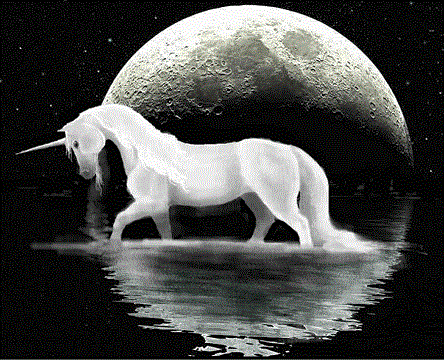 Pliny, the Roman naturalist, out of whose account of the unicorn most of the modern unicorns have been described and figured, records it as "a very ferocious beast, similar in the rest of its body to a horse, with the head of a deer, the feet of an elephant, the tail of a boar, a deep, bellowing voice, and a single black horn, two cubits in length, standing out in the middle of its forehead." He adds that "it cannot be taken alive"; and some such excuse may have been necessary in those days for not producing the living animal upon the arena of the amphitheatre.
Pliny, the Roman naturalist, out of whose account of the unicorn most of the modern unicorns have been described and figured, records it as "a very ferocious beast, similar in the rest of its body to a horse, with the head of a deer, the feet of an elephant, the tail of a boar, a deep, bellowing voice, and a single black horn, two cubits in length, standing out in the middle of its forehead." He adds that "it cannot be taken alive"; and some such excuse may have been necessary in those days for not producing the living animal upon the arena of the amphitheatre.The unicorn seems to have been a sad puzzle to the hunters, who hardly knew how to come at so valuable a piece of game. Some described the horn as movable at the will of the animal, a kind of small sword, in short, with which no hunter who was not exceedingly cunning in fence could have a chance. Others maintained that all the animal's strength lay in its horn, and that when hard pressed in pursuit, it would throw itself from the pinnacle of the highest rocks horn foremost, so as to pitch upon it, and then quietly march off not a whit the worse for its fall.
But it seems they found out how to circumvent the poor unicorn at last. They discovered that it was a great lover of purity and innocence, so they took the field with a young virgin, who was placed in the unsuspecting admirer's way. When the unicorn spied her, he approached with all reverence, crouched beside her, and laying his head in her lap, fell asleep. The treacherous virgin then gave a signal, and the hunters made in and captured the simple beast. (Bulfinch’s Mythology)
Zeus
 The youngest son of Cronus and Rhea, he was the supreme ruler of Mount Olympus and of the Pantheon of gods who resided there. Being the supreme ruler he upheld law, justice and morals, and this made him the spiritual leader of both gods and men.
The youngest son of Cronus and Rhea, he was the supreme ruler of Mount Olympus and of the Pantheon of gods who resided there. Being the supreme ruler he upheld law, justice and morals, and this made him the spiritual leader of both gods and men.Zeus is portrayed in "The Currency of Fire" as a lion. The writer's vision is in keeping with other artist renditions. According to Encyclopedia Mythica, "In art, Zeus was usually portrayed as bearded, middle aged but with a youthful figure. He would look very regal and imposing."
